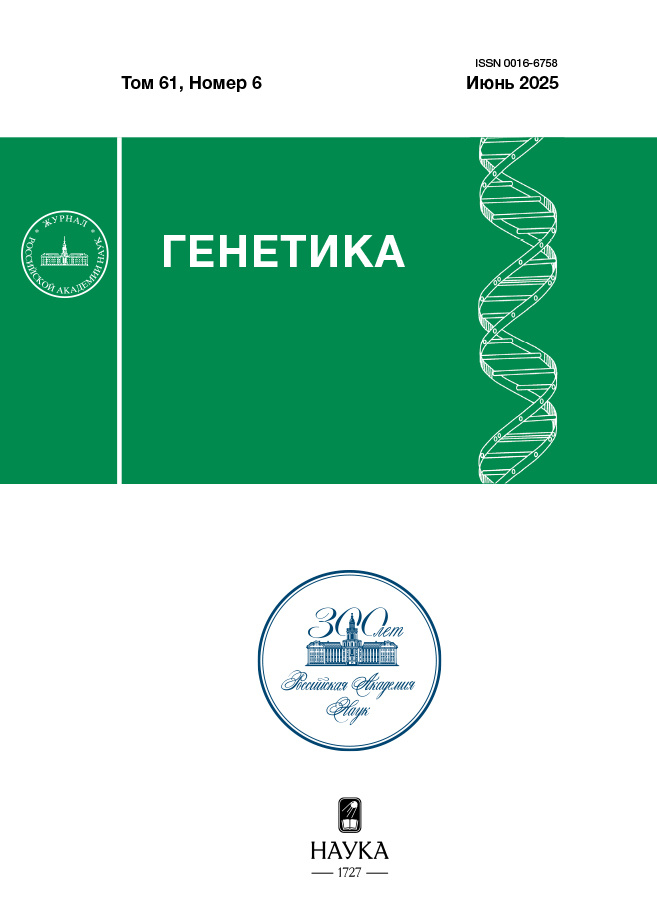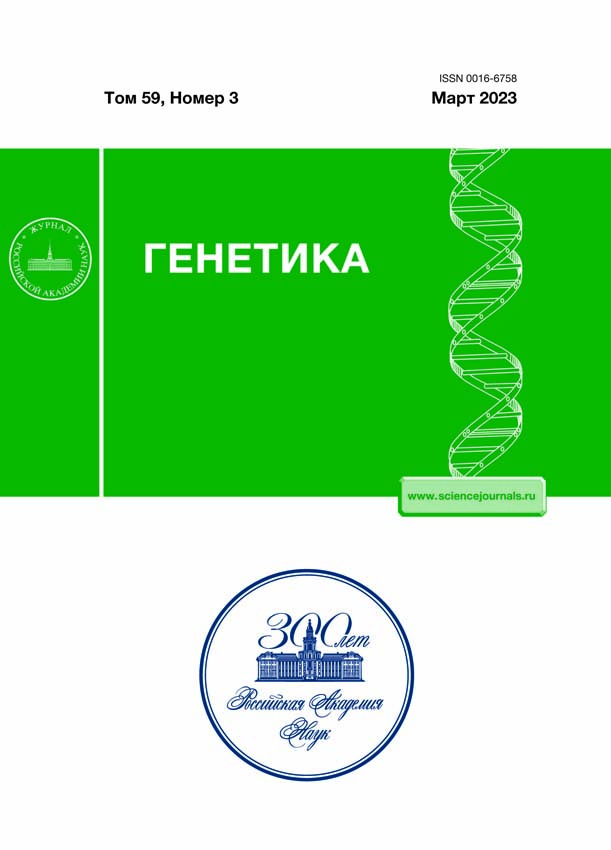Сайты связывания архитектурного белка Su(Hw) стимулируют рекрутирование эпигенетических регуляторов PcG/TrxG на хроматин: CRISPR/Cas9-тест
- Авторы: Ерохин М.М.1, Горбенко Ф.В.1, Ломаев Д.В.1, Четверина Д.А.1
-
Учреждения:
- Институт биологии гена Российской академии наук
- Выпуск: Том 59, № 3 (2023)
- Страницы: 308-315
- Раздел: МОЛЕКУЛЯРНАЯ ГЕНЕТИКА
- URL: https://rjonco.com/0016-6758/article/view/666875
- DOI: https://doi.org/10.31857/S0016675823030049
- EDN: https://elibrary.ru/INYMCX
- ID: 666875
Цитировать
Полный текст
Аннотация
Белки групп Polycomb и Trithorax (PcG и TrxG) являются эпигенетическими факторами, отвечающими за репрессию и активацию транскрипции соответственно. У Drosophila белки PcG/TrxG рекрутируются на специализированные ДНК-элементы, называемые PRE (Polycomb response elements). В зависимости от контекста, данные элементы могут репрессировать, активировать или быть нейтральными по отношению к промотору гена-мишени. Ранее в трансгенных исследованиях с использованием PhiC31 сайт-специфической системы интеграции мы продемонстрировали, что расположенные рядом с PRE сайты для архитектурных белков могут индуцировать репрессорную активность bxdPRE, стимулируя связывание факторов PcG/TrxG с данным элементом. Однако этот эффект может зависеть от дополнительных ДНК-элементов, присутствующих в месте интеграции после PhiC31-зависимой инсерции трансгенов. В настоящем исследовании, используя альтернативную систему интеграции на основе CRISPR/Cas9-катализируемой гомологичной репарации, мы доказали, что сайты связывания архитектурного белка Su(Hw) действительно способны индуцировать репрессорную активность bxdPRE и привлечение белков PcG/TrxG вне зависимости от дополнительных ДНК-элементов, присутствующих в месте интеграции после PhiC31-зависимой инсерции трансгенов.
Ключевые слова
Об авторах
М. М. Ерохин
Институт биологии гена Российской академии наук
Автор, ответственный за переписку.
Email: yermaxbio@yandex.ru
Россия, 119334, Москва
Ф. В. Горбенко
Институт биологии гена Российской академии наук
Email: daria.chetverina@gmail.com
Россия, 119334, Москва
Д. В. Ломаев
Институт биологии гена Российской академии наук
Email: daria.chetverina@gmail.com
Россия, 119334, Москва
Д. А. Четверина
Институт биологии гена Российской академии наук
Автор, ответственный за переписку.
Email: daria.chetverina@gmail.com
Россия, 119334, Москва
Список литературы
- Chetverina D.A., Elizar’ev P.V., Lomaev D.V. et al. Control of the gene activity by Polycomb and Trithorax group proteins in Drosophila // Russian J. Genetics. 2017. V. 53. № 2. P. 133–154.
- Kassis J.A., Kennison J.A., Tamkun J.W. Polycomb and Trithorax group genes in Drosophila // Genetics. 2017. V. 206. № 4. P. 1699–1725. https://doi.org/10.1534/genetics.115.185116
- Schuettengruber B., Bourbon H.M., Di Croce L., Cavalli G. Genome regulation by Polycomb and Trithorax: 70 years and counting // Cell. 2017. V. 171. № 1. P. 34–57. https://doi.org/10.1016/j.cell.2017.08.002
- Chetverina D.A., Lomaev D.V., Erokhin M.M. Polycomb and Trithorax group proteins: The long road from mutations in Drosophila to use in medicine // Acta Naturae. 2020. V. 12. № 4. P. 66–85. https://doi.org/10.32607/actanaturae.11090
- Четверина Д.А., Ломаев Д.В., Георгиев П.Г., Ерохин М.М. Генетические нарушения активности PRC2 при онкологии: проблемы и перспективы // Генетика. 2021. Т. 57. № 3. С. 235–289. https://doi.org/10.31857/S0016675821030048
- Erokhin M., Chetverina O., Gyorffy B. et al. Clinical correlations of Polycomb repressive complex 2 in different tumor types // Cancers (Basel). 2021. V. 13. № 13.https://doi.org/10.3390/cancers13133155
- Piunti A., Shilatifard A. The roles of Polycomb repressive complexes in mammalian development and cancer // Nat. Rev. Mol. Cell. Biol. 2021. V. 22. № 5. P. 326–345. https://doi.org/10.1038/s41580-021-00341-1
- Parreno V., Martinez A.M., Cavalli G. Mechanisms of Polycomb group protein function in cancer // Cell Res. 2022. V. 32. № 3. P. 231–253. https://doi.org/10.1038/s41422-021-00606-6
- Erokhin M., Georgiev P., Chetverina D. Drosophila DNA-binding proteins in Polycomb repression // Epigenomes. 2018. V. 2. № 1. P. 1. https://doi.org/10.3390/epigenomes2010001
- Kuroda M.I., Kang H., De S., Kassis J.A. Dynamic competition of Polycomb and Trithorax in transcriptional programming // Annu. Rev. Biochem. 2020. V. 89. P. 235–253. https://doi.org/10.1146/annurev-biochem-120219-103641
- Kassis J.A. Unusual properties of regulatory DNA from the Drosophila engrailed gene: Three “pairing-sensitive” sites within a 1.6-kb region // Genetics. 1994. V. 136. № 3. P. 1025–1038. https://doi.org/10.1093/genetics/136.3.1025
- Kassis J.A. Pairing-sensitive silencing, polycomb group response elements, and transposon homing in Drosophila // Adv. Genet. 2002. V. 46. P. 421–438. https://doi.org/10.1016/s0065-2660(02)46015-4
- Mihaly J., Hogga I., Gausz J. et al. In situ dissection of the Fab-7 region of the bithorax complex into a chromatin domain boundary and a Polycomb-response element // Development. 1997. V. 124. № 9. P. 1809–1820. https://doi.org/10.1242/dev.124.9.1809
- De S., Cheng Y., Sun M.A. et al. Structure and function of an ectopic Polycomb chromatin domain // Sci. Adv. 2019. V. 5. № 1. P. eaau9739. https://doi.org/10.1126/sciadv.aau9739
- De S., Mitra A., Cheng Y. et al. Formation of a Polycomb-domain in the absence of strong Polycomb response elements // PLoS Genet. 2016. V. 12. № 7. P. e1006200. https://doi.org/10.1371/journal.pgen.1006200
- Erokhin M., Gorbenko F., Lomaev D. et al. Boundaries potentiate Polycomb response element-mediated silencing // BMC Biol. 2021. V. 19. № 1. P. 113. https://doi.org/10.1186/s12915-021-01047-8
- Horard B., Tatout C., Poux S., Pirrotta V. Structure of a Polycomb response element and in vitro binding of Polycomb group complexes containing GAGA factor // Mol. Cell. Biol. 2000. V. 20. № 9. P. 3187–3197. https://doi.org/10.1128/MCB.20.9.3187-3197.2000
- Bischof J., Maeda R.K., Hediger M. et al. An optimized transgenesis system for Drosophila using germ-line-specific phiC31 integrases // Proc. Natl Acad. Sci. USA. 2007. V. 104. № 9. P. 3312–3317. https://doi.org/10.1073/pnas.0611511104
- Port F., Chen H.M., Lee T., Bullock S.L. Optimized CRISPR/Cas tools for efficient germline and somatic genome engineering in Drosophila // Proc. Natl Acad. Sci. USA. 2014. V. 111. № 29. P. E2967–2976. https://doi.org/10.1073/pnas.1405500111
- Gratz S.J., Ukken F.P., Rubinstein C.D. et al. Highly specific and efficient CRISPR/Cas9-catalyzed homology-directed repair in Drosophila // Genetics. 2014. V. 196. № 4. P. 961–971. https://doi.org/10.1534/genetics.113.160713
- Zolotarev N., Maksimenko O., Kyrchanova O. et al. Opbp is a new architectural/insulator protein required for ribosomal gene expression // Nucl. Ac. Res. 2017. V. 45. № 21. P. 12285–12300. https://doi.org/10.1093/nar/gkx840
- Erokhin M., Davydova A., Kyrchanova O. et al. Insulators form gene loops by interacting with promoters in Drosophila // Development. 2011. V. 138. № 18. P. 4097–4106. https://doi.org/10.1242/dev.062836
- Siegal M.L., Hartl D.L. Application of Cre/loxP in Drosophila. Site-specific recombination and transgene coplacement // Methods Mol. Biol. 2000. V. 136. P. 487–495. https://doi.org/10.1385/1-59259-065-9:487
- Melnikova L., Elizar’ev P., Erokhin M. et al. The same domain of Su(Hw) is required for enhancer blocking and direct promoter repression // Sci. Rep. 2019. V. 9. № 1. P. 5314. https://doi.org/10.1038/s41598-019-41761-6
- Erokhin M., Davydova A., Parshikov A. et al. Transcription through enhancers suppresses their activity in Drosophila // Epigenetics Chromatin. 2013. V. 6. № 1. P. 31. https://doi.org/10.1186/1756-8935-6-31
- Erokhin M., Elizar’ev P., Parshikov A. et al. Transcriptional read-through is not sufficient to induce an epigenetic switch in the silencing activity of Polycomb response elements // Proc. Natl Acad. Sci. USA. 2015. V. 112. № 48. P. 14930–14935. https://doi.org/10.1073/pnas.1515276112
- Ray P., De S., Mitra A. et al. Combgap contributes to recruitment of Polycomb group proteins in Drosophila // Proc. Natl Acad. Sci. USA. 2016. V. 113. № 14. P. 3826–3831. https://doi.org/10.1073/pnas.1520926113
- Chetverina D., Aoki T., Erokhin M. et al. Making connections: Insulators organize eukaryotic chromosomes into independent cis-regulatory networks // Bioessays. 2014. V. 36. № 2. P. 163–172. https://doi.org/10.1002/bies.201300125
- Chetverina D., Fujioka M., Erokhin M. et al. Boundaries of loop domains (insulators): Determinants of chromosome form and function in multicellular eukaryotes // Bioessays. 2017. V. 39. № 3. https://doi.org/10.1002/bies.201600233
Дополнительные файлы














